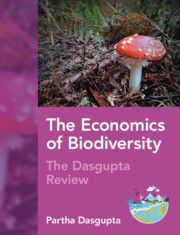Book contents
- The Economics of Biodiversity
- The Economics of Biodiversity
- Copyright page
- Contents
- List of Boxes
- Foreword
- Preface to the CUP Edition
- Preface
- Part I Foundations
- Part II Extensions
- Chapter 14 Distribution and Sustainability
- Chapter 15 Trade and the Biosphere
- Chapter 16 Demand for Provisioning Goods and Its Consequences
- Chapter 17 Managing Nature-Related Financial Risk and Uncertainty
- Chapter 18 Conservation of Nature
- Chapter 19 Restoration of Nature
- Chapter 20 Finance for Sustainable Engagement with Nature
- Part III The Road Ahead
- Appendix
- Acronyms
- Glossary
- References
- Acknowledgements
- Author Index
- Subject Index
Chapter 19 - Restoration of Nature
from Part II - Extensions
Published online by Cambridge University Press: 10 March 2025
- The Economics of Biodiversity
- The Economics of Biodiversity
- Copyright page
- Contents
- List of Boxes
- Foreword
- Preface to the CUP Edition
- Preface
- Part I Foundations
- Part II Extensions
- Chapter 14 Distribution and Sustainability
- Chapter 15 Trade and the Biosphere
- Chapter 16 Demand for Provisioning Goods and Its Consequences
- Chapter 17 Managing Nature-Related Financial Risk and Uncertainty
- Chapter 18 Conservation of Nature
- Chapter 19 Restoration of Nature
- Chapter 20 Finance for Sustainable Engagement with Nature
- Part III The Road Ahead
- Appendix
- Acronyms
- Glossary
- References
- Acknowledgements
- Author Index
- Subject Index
Summary
Restoration seeks to assist Nature recover from a degraded, damaged – even dilapidated – state. Potential benefits from restoring our ecosystems have been discussed earlier in the Review (see in particular Chapter 2). Restored ecosystems are more effective at providing regulating services, which have been lost in many places due to overharvesting of provisioning goods (Chapters 2 and 16). Restoration can make a significant contribution to the mitigation of, and adaptation to, climate change. Successful restoration requires a wider understanding of the relationship between people, Nature and livelihoods, and effective institutions. It relies on sound science, clear objectives, community engagement, monitoring and evaluation (Wortley, Hero, and Howes, 2013; Perring et al. 2015; Gann et al. 2019).
- Type
- Chapter
- Information
- The Economics of BiodiversityThe Dasgupta Review, pp. 457 - 472Publisher: Cambridge University PressPrint publication year: 2024

